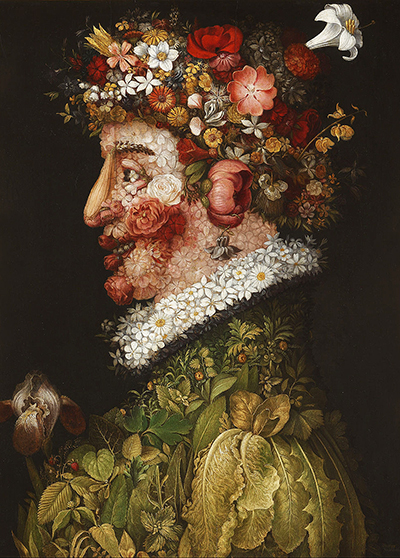La Primavera is one of a set of oil-on-canvas paintings entitled The Four Seasons, created in 1563 and 1572-1573 by Giuseppe Arcimboldo. The artist was an Italian Mannerist who assembled objects, animals and plants in the manner of a portrait.
While working as a court painter for the Hapsburgs in Prague, he produced backdrops for the royal theatre. It was then that he became interested in visual illusions of the type used in La Primavera, which is not what it seems at first glance. His eccentric style is full of puns, jokes and allegorical content. Mannerism comes from the Italian word maniera, meaning style. Whether Arcimboldo simply shifted to an idiosyncratic style in reaction to the classicism of the Renaissance and the painters he admired, such as Raphael, or whether he saw it as an extension of those masterpieces, mannerism is now regarded as a link to the Baroque period.
Each of the four pictures of the Four Seasons made use of produce appropriate to its particular season, with the whole set being forwarded to Maximilian II in 1569, together with Giovanni Battista Fonteo's poem to explain the allegorical significance of the works. La Primavera, or spring, portrays what seems to be a woman facing left, but the face is composed entirely of a myriad of flowers. Rose buds and petals make up the skin, with Belladonna berries for eyes, and a floral bouquet for hair. Thick layers of leaves in diverse shades and shapes make up the upper body, with a necklace of daisies around the neck.
Appropriately, La Primavera was the first of the cycle, and the remaining three follow this interpretation. The arrangement of the vegetation resembles a royal portrait, with a crown and ruffled collar. Depictions of the seasons usually refer to the four ages of humankind, with spring signifying birth, rebirth and childhood. The others are adolescence, adulthood and old age. The first sight of La Primavera can be a bit of a shock, especially as it gradually dawns on the onlooker that this isn't actually a person. Arcimboldo's output must have been doing this to viewers for centuries, but today, surrealism is the first word that comes to mind, and indeed, Salvador Dalí and other surrealists were inspired and influenced by Giuseppe Arcimboldo's style.
His more conventional works are not well-known today, but portraits such as La Primavera are still of interest. Unfortunately, only two of the original series remain, with Summer and Winter now held by Vienna's Kunsthistorisches Museum. Copies were made at the time for Augustus of Saxony, and these are in the Louvre, with the addition of floral frames. A set was also copied for the Spanish king, Philip II, and of these, Spring survived, and is in Madrid's Real Academia de San Fernando.




